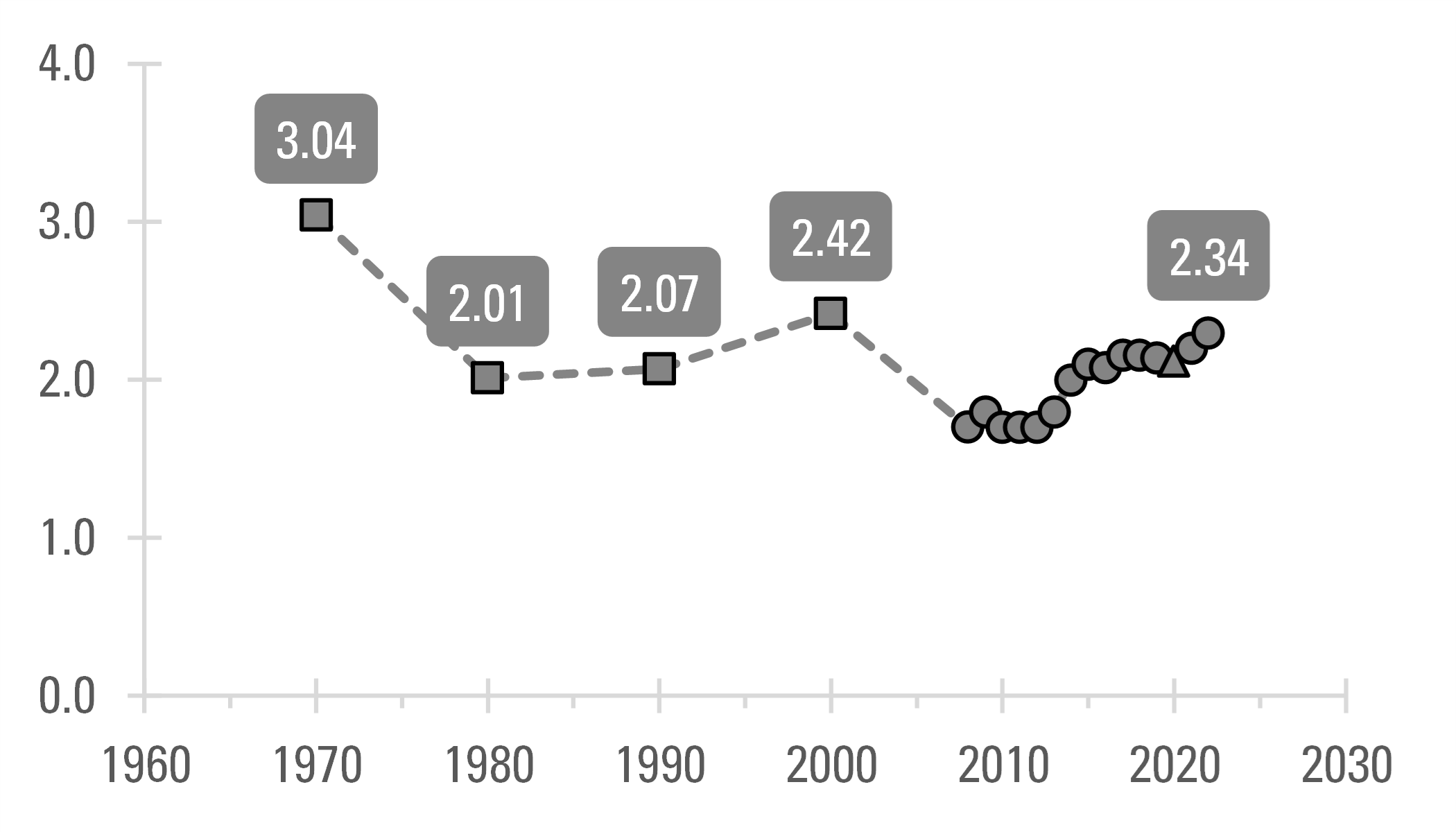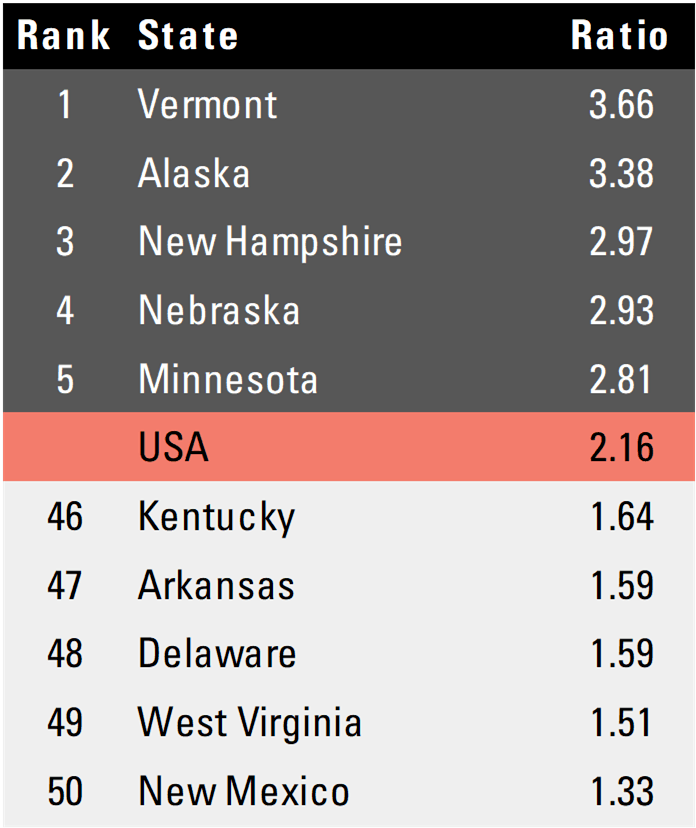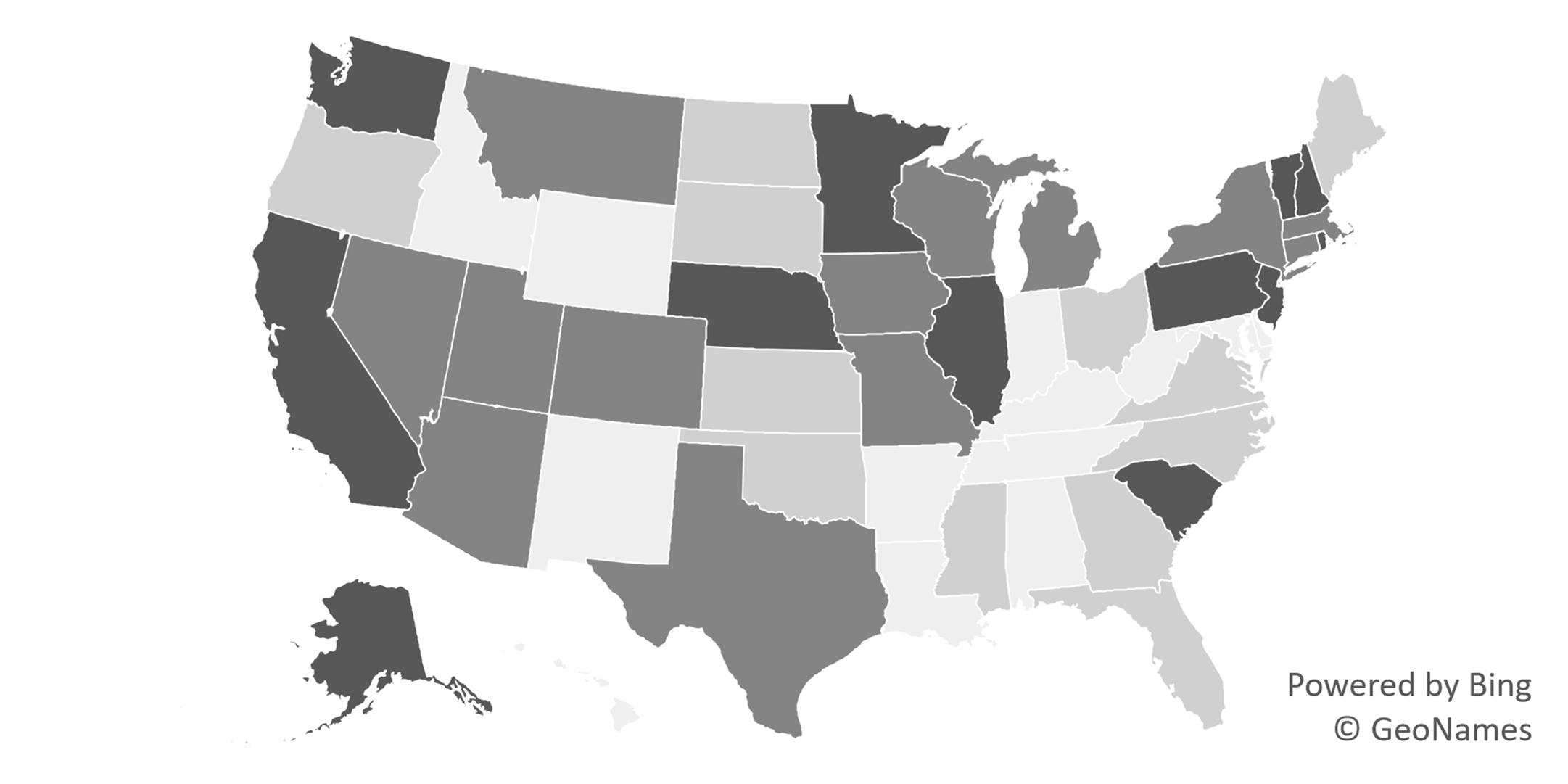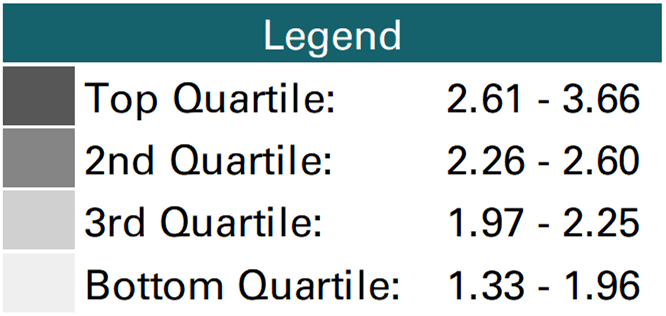Marriage-to-Divorce Ratio in the U.S.: Geographic Variation, 2022
Family Profile No. 25, 2023
Author: Jaden Loo
This family profile updates previous profiles on the marriage-to-divorce ratio (Juteau & Marino, 2022, Reynolds, 2020; Schweizer, 2019; Schweizer, 2019b; Wu, 2017; Eickmeyer, 2015) and examines state variation in the ratio of marriages to divorces. Using recent American Community Survey (ACS) data, we calculate national and state level marriage-to-divorce ratios by dividing the number of women’s marriages by the number of women’s divorces for a given population in a given year.
Note: Counts for Washington D.C. are excluded from this profile due to observed irregularities in divorce count estimates by sex over time in the ACS. Although estimates remained within the margin of error for the estimates, the margins of error increased dramatically in 2022.
U.S. Marriage-to-Divorce Ratio, 2022
- In 2022, more than two marriages occurred for every one divorce in the United States (ratio = 2.34). There were 2,315,440 marriages and 989,518 divorces, both of which are increases from the counts from 2021 (2,052,806 and 948,862 respectively).
- The ratio remained stable from 2015 through 2021 ranging from 2.10 to 2.16, meaning approximately two marriages for every one divorce (FP-22-27). The most recent data from 2022 indicates an uptick and represents the largest marriage to divorce ratio since the ACS began collecting information on recent marriage and divorce experience in 2008.
Figure 1. Ratio Time Trend, 1970-2022

Five Highest and Lowest Marriage-to-Divorce Ratios, 2022
- All states had a greater number of marriages than divorces. Vermont (3.66), Alaska (3.38), and New Hampshire (2.97) had the highest marriage-to-divorce ratios in 2022.
- Vermont went from being ranked the 50th state in 2021 (1.54) to the 1st in 2022 (3.66).
- Only two states from the top 5 highest ratios of 2021 (Alaska and New Hampshire) returned to the top 5 in 2022.
- The states with the lowest marriage-to-divorce ratios were New Mexico (1.33), West Virginia (1.51), and Delaware (1.59).
- New Mexico was the only US state to see fewer than 1.5 marriages for every one divorce (ratio = 1.33).
- The only state from the bottom 5 ratios of 2021 that returned in 2022 was West Virginia.
Figure 2. Highest and Lowest Marriage-to-Divorce Ratios, 2022

State Rankings and Geographic Variation in Marriage-to-Divorce Ratio, 2022
- Except for the Northeast which had zero states in the bottom quartile, the other three US Census Regions (West, Midwest, and South) contained at least one state in all four quartiles.
- Similar to 2021, a majority of the states in the top quartile of Marriage to Divorce Ratios were found in the Northeast.
- For those in the Western region of the U.S., their ratios most often fell in the top 2 quartiles.
- Exceptions included Oregon, Idaho, Wyoming, and New Mexico.
- Other than Texas and South Carolina, all states in the South were in the bottom two quartiles.
- The Midwest only contained one state (Illinois) in the bottom quartile, with a relatively even distribution among the other three quartiles.
Figure 3. State-Level Marriage-to-Divorce Ratio by Quartile, 2022

Figure 4. Geographic Variation of Women’s Adjusted Divorce Rate Among States, 2022


Source: NCFMR analyses of U.S. Census Bureau, American Community Survey, 2022 1-yr est.
Data Sources:
Clarke. S. C. (1995). Advanced report of final marriage statistics, 1989 and 1990. Monthly Vital Statistics Report, 42(12). National Center for Health Statistics. https://www.cdc.gov/nchs/data/mvsr/mv43_12.pdf
National Center for Health Statistics (1974). Summary report final marriage statistics, 1970. Monthly Vital Statistics Report, 23(2), Supp. 1. U.S. Department of Health, Education, and Welfare. https://www.cdc.gov/nchs/data/mvsr/supp/mv23_02s1acc.pdf
National Center for Health Statistics (1977). Advance report of final divorce statistics, 1975. Monthly Vital Statistics Report, 26(2), Supp. 2. U.S. Department of Health, Education, and Welfare. https://www.cdc.gov/nchs/data/mvsr/supp/mv26_02s2acc.pdf
National Center for Health Statistics (1983). Advance report of final marriage statistics, 1980. Monthly Vital Statistics Report, 32(5), Supp. U.S. Department of Health and Human Services. https://www.cdc.gov/nchs/data/mvsr/supp/mv32_05s.pdf
National Center for Health Statistics (2001). Births, marriages, divorces, and deaths: Provisional data for January-December 2000. National Vital Statistics Report, 49(6), Associated Table 3. Department of Health & Human Services, Center for Disease Control and Prevention. https://www.cdc.gov/nchs/data/nvsr/nvsr49/nvsr49_06.pdf
U.S. Census Bureau (2019). American Community Survey, 2019 1-Year Estimates [Table B12001]. https://data.census.gov/cedsci/table?q=B12001&lastDisplayedRow=18&table=B12001&tid=ACSDT1Y2018.B12001
U.S. Census Bureau (2019). American Community Survey, 2019 1-Year Estimates [Table B12503]. https://data.census.gov/cedsci/table?q=B12503&hidePreview=false&table=B12503&tid=ACSDT1Y2018.B12503&lastDisplayedRow=10
U.S. Census Bureau (2021). American Community Survey, 2020 1-year Experimental PUMS
References:
Reynolds, L. R. (2020). Marriage to Divorce Ratio in the U.S.: Geographic Variation, 2019. Family Profile, (FP-20-26). National Center for Family & Marriage Research. https://doi.org/10.25035/ncfmr/fp-20-26
Schweizer, V. (2019). Marriage to Divorce Ratio in the U.S.: Geographic Variation, 2018. Family Profile, (FP-19-24). National Center for Family & Marriage Research. https://doi.org/10.25035/ncfmr/fp-19-24
Schweizer, V. (2019). Marriage to Divorce Ratio in the U.S.: Geographic Variation, 2017. Family Profile, (FP-19-03). National Center for Family & Marriage Research. https://doi.org/10.25035/ncfmr/fp-19-03
Wu, H. (2017). Marriage to Divorce Ratio in the U.S.: Geographic Variation, 2015. Family Profile, (FP-17-01). National Center for Family & Marriage Research. https://www.bgsu.edu/content/dam/BGSU/college-of-arts-and-sciences/NCFMR/documents/FP/wu-mar-to-div-ratio-2015-fp-17-01.pdf
Eickmeyer, K.J. (2015). Marriage to Divorce Ratio in the U.S.: Geographic Variation, 2014. Family Profile, (FP-15-19). National Center for Family & Marriage Research. https://www.bgsu.edu/content/dam/BGSU/college-of-arts-and-sciences/NCFMR/documents/FP/eickmeyer-mar-div-ratio-us-geo-2014-fp-15-19.pdf
Suggested Citation:
Loo, J. (2023). Divorce rate in the U.S.: Geographic variation, 2022. Family Profiles, FP-23-25. Bowling Green, OH: National Center for Family & Marriage Research. https://doi.org/10.25035/ncfmr/fp-23-25
Updated: 11/07/2025 04:48PM


